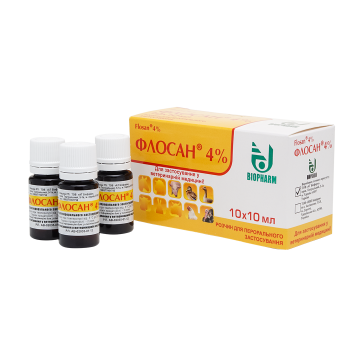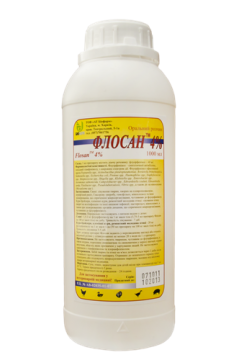FLOSAN® 4%
solution for oral administration
Description
Transparent viscous solution.
Composition
1 ml of the drug contains:
active ingredient: florfenicol – 40 mg;
Excipients: PEG-400.
solution for oral administration
Description
Transparent viscous solution.
Composition
1 ml of the drug contains:
active ingredient: florfenicol – 40 mg;
Excipients: PEG-400.
Pharmacological properties
АТСvet: QJ01 - antibacterials for systemic use. QJ01BA90 - Florfenicol.
Florfenicol is a synthetic broad-spectrum antibiotic, a thiamphenicol derivative. The antibiotic is effective against Pasteurella spp., Actinobacillus pleuropneumoniae, Bordetella bronchiseptica, Salmonella spp., Escherichia coli, Proteus spp., Haemophilus spp., Staphylococcus spp., Streptococcus spp., Shigella spp., Klebsiella spp., Enterobacter spp., Aeromonas salmonicida, Campylobacter spp., Edwardsiella ictaluri, Edwardsiella tarda, Flexibacter spp., Yersinia pseudotuberculosis, Vibrio spp., as well as mycoplasma (Mycoplasma spp.). The mechanism of action consists in inhibition of microbial cell peptidyl transferase enzyme activity, particularly – in the area of 70S ribosomes.
After oral administration, florfenicol is well absorbed (up to 90%) from digestive tract and distributed in organs and tissues, reaching concentrations of 4-8 μg/g in lungs, heart, pancreatic gland, skeletal muscles and spleen. Relatively high concentrations are present in bile, kidneys, small intestine and urine. Half-life of florfenicol makes 2.6-3.2 hours on average. It is primarily excreted renally unchanged through glomerular filtration, as well as in bile, being inactivated through formation of chelate compounds, then they are excreted in feces.
Administration
Swine: treatment of animals against pleuropneumonia, atrophic rhinitis, Glasser’s disease, mycoplasmosis and other diseases caused by florfenicol-sensitive microorganisms (Actinobacillus pleuropneumoniae, Pasteurella multocida, Bordetella bronchiseptica, Haemophilus parasuis, Pasteurella multocida, Bordetella bronchiseptica).
Poultry (broiler chickens, breeding hens, pullets): colisepticemia, pasteurellosis, mycoplasmosis as well as diseases of respiratory organs and digestive tract caused by florfenicol-sensitive microorganisms.
Dosage
Orally with drinking water in the following doses:
swine: 3.75-5 ml of the drug per 100 kg body weight (1.5-2 mg of florfenicol per 1 kg body weight) daily. Duration of treatment – 7 days;
poultry (broiler chickens, breeding hens, pullets) 50 ml of the drug per 100 kg body weight (20 mg of florfenicol per 1 kg body weight) daily. Duration of treatment: 3-5 days.
Through the dispenser, the drug is administered in undiluted form or a mother solution is prepared in a ratio of at least 20 litres of water per 1 litre of the drug.
Contraindications
Do not administer to animals with hypersensitivity to florfenicol.
Do not use for breeding boars, pregnant and lactating sows.
Do not administer to hens laying eggs for human consumption.
Do not use in combination with thiamphenicol and chloramphenicol.
Precautions
Animal slaughter for meat is possible in 2 days following the last administration of the drug. Meat, obtained before the mentioned term shall be utilized or fed to non-productive animals depending on the statement of a veterinary physician.
Changes in colour of feces, diarrhea, redness or swelling of rectal perianal section, which disappear after withdrawal, are possible.
Packaging
Plastic vials of 10, 100 and 1000 ml.
Storage
Store in a dry, dark, damp-proof place out of reach of children at 5-30°С.
Shelf life
2 years.
24 hours after dissolution in water.
For use in veterinary medicine!



